AMD AM1 Kabini Part 2: Athlon 5350/5150 and Sempron 3850/2650 Tested
by Ian Cutress on May 29, 2014 2:00 PM ESTCPU Synthetic Benchmarks
Content Creation - Cinebench
Based on MAXON’s CINEMA 4D animation software, Cinebench is used to determine the CPU and graphics performance via OpenGL. The software has gone through many iterations over the years, and here we use versions 10, 11.5 and 15 to compare single-threaded and multi-threaded CPU performance. As the generations increase, the software becomes more multithread aware and scales better, however for consistency with older results we keep the version 10 results in our database.
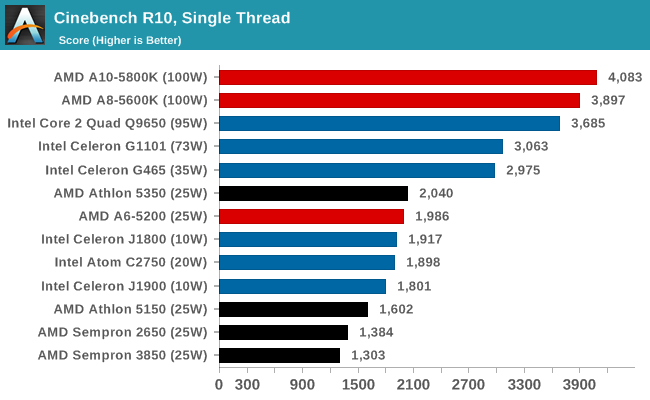
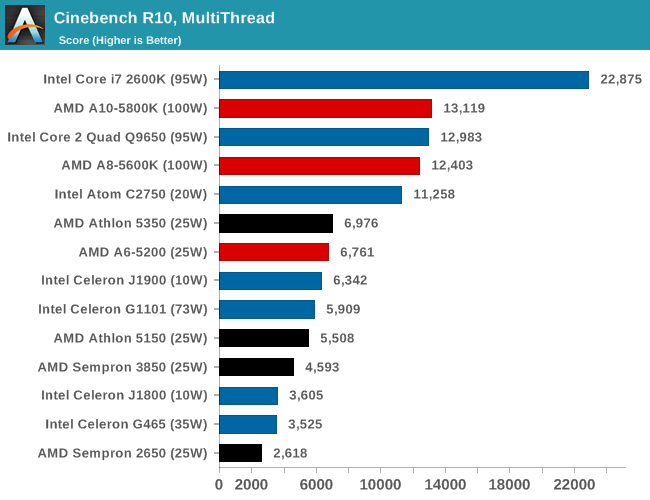
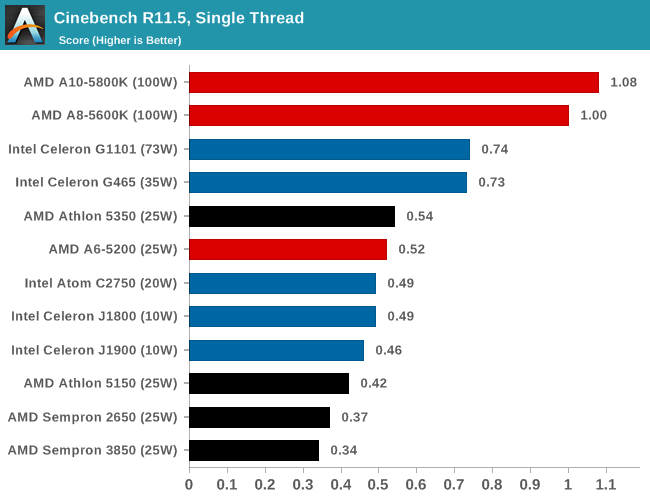
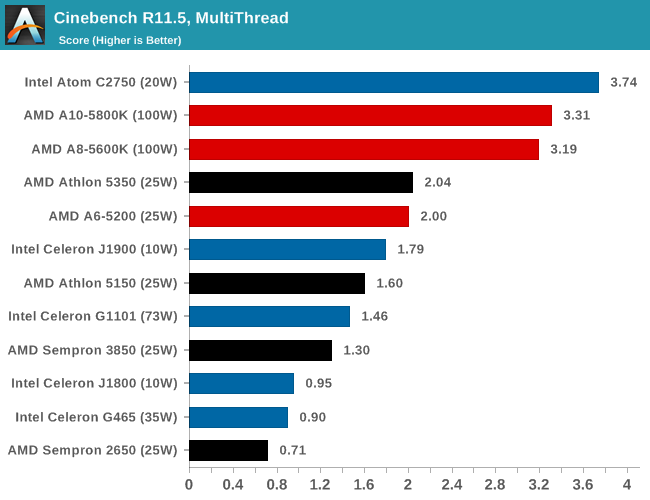
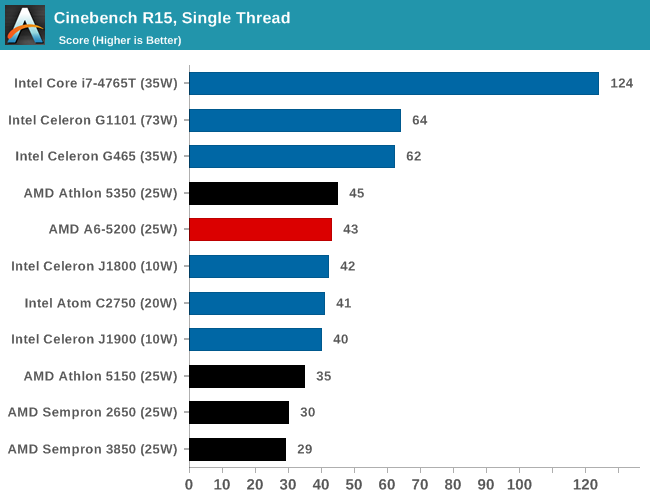
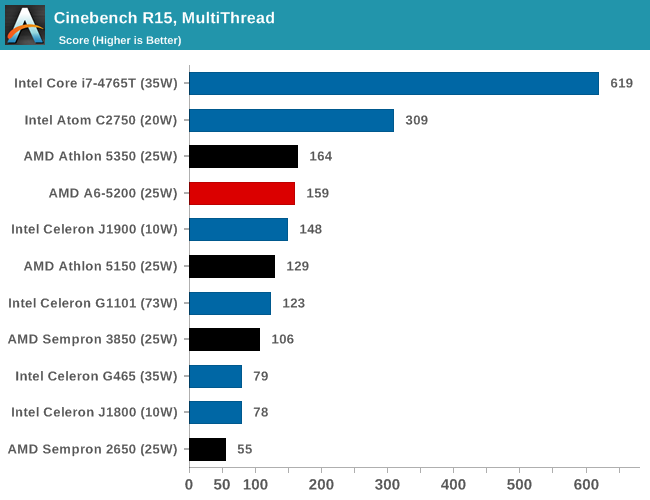
Synthetic – 7-Zip 9.2: link
As an open source compression tool, 7-Zip is a popular tool for making sets of files easier to handle and transfer. The software offers up its own benchmark, to which we report the result.
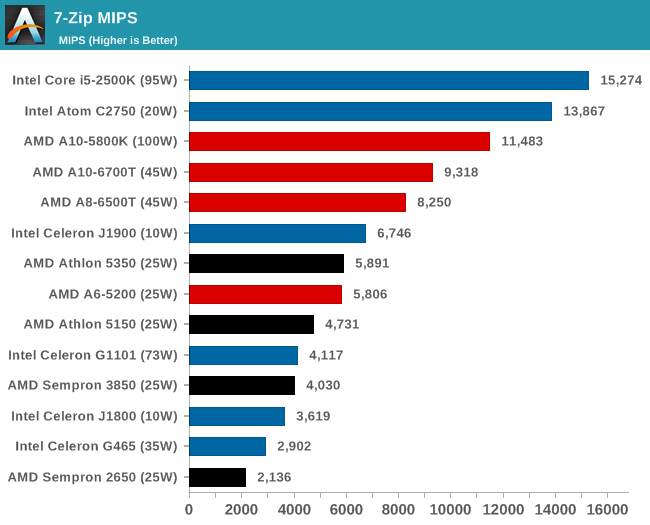
Rendering – PovRay 3.7: link
The Persistence of Vision RayTracer, or PovRay, is a freeware package for as the name suggests, ray tracing. It is a pure renderer, rather than modeling software, but the latest beta version contains a handy benchmark for stressing all processing threads on a platform. We have been using this test in motherboard reviews to test memory stability at various CPU speeds to good effect – if it passes the test, the IMC in the CPU is stable for a given CPU speed. As a CPU test, it runs for approximately 2-3 minutes on high end platforms.

Console Emulation –Dolphin Benchmark: link
At the start of 2014 I was emailed with a link to a new emulation benchmark based on the Dolphin Emulator. The issue with emulators tends to be two-fold: game licensing and raw CPU power required for the emulation. As a result, many emulators are often bound by single thread CPU performance, and general reports tended to suggest that Haswell provided a significant post to emulator performance. This benchmark runs a Wii program that raytraces a complex 3D scene inside the Dolphin Wii emulator. Performance on this benchmark is a good proxy of the speed of Dolphin CPU emulation, which is an intensive single core task using most aspects of a CPU. Results are given in minutes, where the Wii itself scores 17.53; meaning that anything scoring better than this is faster than an actual Wii for processing Wii code, albeit emulated.











87 Comments
View All Comments
Eeqmcsq - Thursday, May 29, 2014 - link
"... Results are given in minutes, where the Wii itself scores 17.53; meaning that anything above this is faster than an actual Wii..."I think you mean anything "below" this number, since the measurement is in time.
Ian Cutress - Thursday, May 29, 2014 - link
'Above' being above on the graph. I'll just change the wording. I thought I had changed my explanatory template, guess it didn't save...Metalliax - Thursday, May 29, 2014 - link
Why can't review sites please start using sub 150W PSUs for these tests! You should delete your power chart completely unless you can show actual power draw with a PSU that would actually be used in such a setup. I can't believe you think you can post such nonsense with a 1250W PSU.extide - Thursday, May 29, 2014 - link
X2 ! I know you have your reason for using the 1250W PSU (so it's always the same) but the result is USELESS NUMBERS. It doesnt matter if they are comparable if they are utterly useless!easp - Thursday, May 29, 2014 - link
Good call!CU - Thursday, May 29, 2014 - link
Yes, adding haswell celerons like the g1820 and pentiums like the g3220 would be very helpful. Those cpu's plus MB's cost about the same as the Ahtlon 5350.savagemike - Thursday, May 29, 2014 - link
Agree completely. Due to similar costs and the fact I can't passively cool the AMD stuff anyway these are the Intels I'd be comparing them to for a budget build.azazel1024 - Thursday, May 29, 2014 - link
I guess you can consider the IGP benchmarks for something, because I assume it would mean some older and more casual games would be likely to run fine, where as with the Bay Trail IGP they might not. However, at least based on the benchmarks used, even the AMD's IGP here in these low end processors is not up to the task of playable frame rates. Unless I am missing something, this was 1280x1024 at LOWEST settings and they were hitting mid 20's on average frame rates. That may be playable to some and bumping it down to 1280x720 might get you in to the low 30's...but that is still barely, barely playable at best.Which makes me wonder...what would a Pentium or Celeron Haswell that might cost less manage in terms of performance. The IGP is a fair amount more capable, especially the ones with HD4400 on there...which is MASSIVELY more performance than either the Bay Trail or Kabini has...at the same price. Granted, higher TDP, but based on what I know of the actual power consumption of the processors, Haswell Celeron/Pentium might only be a litteral handful of watts more (5-10) under load and probably around the same idle.
Low end board + low end Haswell processor runs ~$100 combined...same price as the high end Kabini and WAYYYYYY more performance.
ozzuneoj86 - Thursday, May 29, 2014 - link
I don't really understand the inclusion of so many recent high end chips. For future reviews of this nature you could probably cut out all but one mid\high end CPU from each vendor, and you'd save a huge amount of benchmarking time.Along with that, it doesn't seem like I've really learned much from many of the benchmarks, since all we have to compare are high end, high TDP CPUs from the past 3 years, and these AM1 Kabini chips... as expected, the Kabinis are all similar in performance (with slight increases from least to most expensive), and the high end CPUs are significantly faster. Readers probably already knew that without the benchmarks though.
It'd be far more useful to compare these to older CPUs and their low wattage variants, such as Core 2 Duos and Quads, AM2\AM3 Athlon X2 and X4 CPUs, as well as other low power chips that are common these days, like the Ivy Bridge based Celeron 1037u, Sandy Bridge Celeron 847, AMD E-350... even an old Atom (from the Ion platform era) would be helpful for those upgrading aging HTPCs. Not to mention any of the direct competition for these chips, like the Ivy\Haswell Celerons and Pentiums.
It'd also be nice to have something to compare the dedicated GPU results to... like the Celeron J1900, or any of the CPUs mentioned above. There are many J1800\J1900 boards out there that can have a dedicated GPU installed.
Also, as others have mentioned, the power consumption numbers with such a high wattage PSU aren't very helpful either.
If its a matter of not having the hardware on hand, we're talking about low end hardware... you could probably get a decent example of almost everything I mentioned for a few hundred dollars total. Besides, I'm sure readers would gladly donate some hardware if it meant having it used in benchmarks for a few years.
Thanks for the article, I just feel like it could have been much more focused on the products being reviewed and how they compare to the competition.
ozzuneoj86 - Thursday, May 29, 2014 - link
Just remembered something else...The game benchmarks need to include older games. One or two examples of recent games that are nearly unplayable would be enough to let us know what we can't do with these... but a few old games, or even highly popular current games that don't require much power would be far more likely to influence someone's buying decisions.
Will it run Minecraft at 1080P? How about 720P? How about a few games from 4-5 years ago?